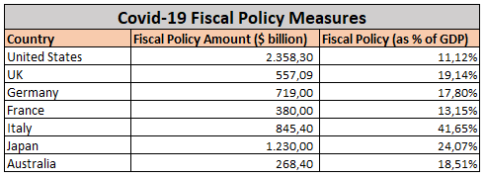Measures to support the economy as a significant GDP percentage.
Covid-19, which has spread around the world in recent months, is having a very violent impact on society. The ease with which it spreads is impressive, and the number of people infected is very high. To date, according to data provided by the World Health Organization, it is estimated that, since the start of the pandemic, there have been more than 1.2 million infected worldwide. The number of new cases rises steadily, although signs of a slowdown in the pandemic begin to appear in some countries. In all countries, research is underway to develop a vaccine and to experiment with drugs that are capable of fighting the virus. Despite the commitments, specialists predict that the cure will be available no earlier than a year. The effects of Covid-19 are extremely heavy, both from a health and economic point of view, with most of the world economies in complete lockdown. In this analysis, we want to focus precisely on this second aspect, deepening the expected economic impact of the virus, and the support measures implemented by governments and central banks so far.
2020 Economic Outlook after Covid-19
Through the analysis of the different forecasts published by the main investment houses, it is possible to note how the expectations on economic growth in 2020 worsened in March 2020, compared to what was expected at the end of 2019 before the spread of the pandemic (Table 1). On average, for all countries, negative GDP growth is expected at the end of the year, caused precisely by the impact of Covid-19 on the economy.

Table 1: GDP Economic Outlook as consequence of Covid-19.
Fiscal Policy Interventions
According to what has happened, governments have taken steps to set up important fiscal measures aimed at supporting the economy by providing liquidity to businesses and families. Below we present the aggregated data on the amount of measures introduced by the governments of the main world economies (Table 2). In the analysis, we did not consider the interventions implemented by China which, despite being in line with the supports provided by other countries, does not provide enough data to be able to expose. To date, the amount of support introduced by states represents a significant percentage of the GDP. This highlights the weight of the manoeuvres implemented so far.

Table 2: Covid-19 Fiscal Policy Measures (as percentage of GDP).
Monetary Policy Interventions
Governments are supported by central banks. The main financial institutions have decided to implement important manoeuvres, aimed at guaranteeing liquidity to the states (by purchasing government bonds) and to the banking system (through repo operations and cuts to bank reserve requirements), thus supporting credit to families and businesses. Below (Table 3), the measures carried out by the central banks of the main world economies.
Table 3: Covid-19 Monetary Policy Measures
To Conclude...
Covid-19 is having a violent effect on society and the economy. Equally violent, however, was the global intervention of all governments and financial institutions, which have introduced manoeuvres well above what are expected to be the effects of the pandemic on the economy at the end of 2020. Governments have declared to be only at the beginning, and to be willing to implement further interventions in case of need. Covid-19 is certainly a temporary situation, and once it is over, what it could leave is the aid allocated to the economy. The huge supports not only could reabsorb the impact caused by the virus but could also generate a very strong boost for economies. To date, however, it is still difficult to accurately estimate the final effects of what is happening. The data provided is forecast and the manoeuvres are constantly updated. It is also still difficult to understand when it will be possible to return to "normality". According to estimates and in the face of an initial slowdown in diffusion, normal activities could be expected to resume in September 2020 for the last countries that entered the crisis. Considering the above, updates will follow in the next analyses.
